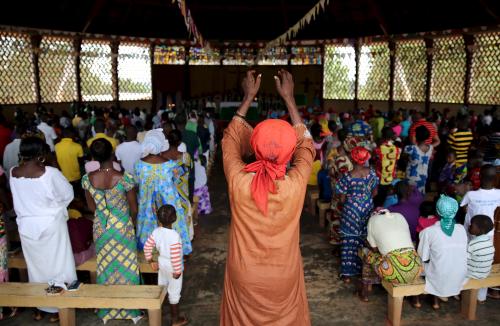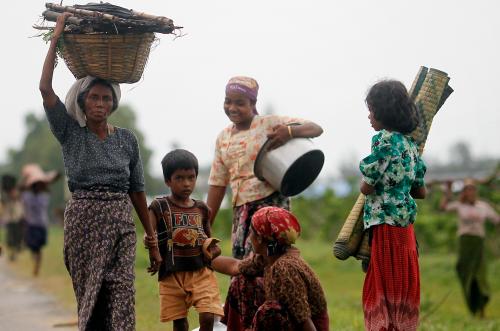Content from the Brookings Doha Center is now archived. In September 2021, after 14 years of impactful partnership, Brookings and the Brookings Doha Center announced that they were ending their affiliation. The Brookings Doha Center is now the Middle East Council on Global Affairs, a separate public policy institution based in Qatar.
PBS Frontline
turned to 10 experts — Syrian activists, journalists who have reported from the country’s dangerous front lines, and analysts who specialize in the region — to explain the long-term impacts of Syria’s deadly conflict. Below, you will find Salman Shaikh’s excerpts from the Frontline piece.
There are reports that thousands of the country’s Alawites are fleeing regions with bigger Alawi populations like Latakia and Tartous. Some have even speculated the eventual formation of an Alawite state in these coastal areas as an option of last resort. What are the prospects for some sort of a separate Alawite refuge in Syria as the conflict continues?
I don’t believe that there is a realistic prospect for a retreat of Alawi communities to the mountainous areas of northwest Syria, as some have suggested. Over the course of the last 80 years or so, Alawi communities have become increasingly urbanized and no longer represent a unified, geographically distinct bloc.
What is more, I am unconvinced that most Alawis would choose to follow the regime rather than stay where they are if the Assads do retreat to their traditional base. Increasing numbers of Alawis are already in touch with the opposition — at great risk to their safety — seeking the sort of reassurances that will encourage them to abandon the regime.
What are the longer-term regional ramifications of the Syrian refugee crisis?
These figures point to the reality of what is a rapidly deteriorating humanitarian crisis. Those refugees join millions of others across the region – some of who have been tragically without a permanent home for decades. These refugees can also represent a huge strain on local communities, and are likely to affect the security and stability of neighboring states.
Syria has five of the most sensitive borders in the world and instability on those borders represents a dangerous development. We face the prospect of increasing terrorism and insecurity in Turkey, the reigniting of sectarian conflict in Lebanon, a further uptick in Sunni-Shia violence in Iraq, and even the possibility that Israel’s northern borders will be challenged or compromised.
When the Syrian uprising first broke out, there were many who predicted it would be mere months before President Assad’s regime fell. A year and a half later, and a slew of failed international efforts to resolve the crisis, the regime is still intact. What’s behind its survival, and what would it take to end the conflict?
In the absence of a united international will to pressure and isolate Bashar al-Assad, his regime was always likely to last longer than some expected. At the outset, many assumptions were based on the eventual alignment of international powers behind a transition of power — particularly once the Arab League had backed that course. Alongside the impotence of a divided U.N. Security Council, the regime was able to benefit from the direct support of reliable allies in Iran and Russia.
On the other side, those in the international community that have called for an end to Assad’s rule have not shown the political will to adopt some of the tougher options in support for Syrians striving for that goal on the ground.
In addition to financial and other sanctions targeted towards regime figures, the U.S. and other Western allies have — at least until very recently — largely relied on a fruitless diplomatic course centered on shifting Russia and China’s stance.
In the meantime, the Assad regime’s brutal campaign against protestors – civil and armed – has been calibrated to make the most of this diplomatic back-and-forth. While its modus operandi has always been fear, intimidation, and violence, the regime has gradually escalated the severity of its onslaught in a way that allowed it to maintain the degree international support necessary for its survival.
At this point in the conflict, is a diplomatic or negotiated political solution still possible?
Competition between rebel groups for arms, money, and influence is becoming an uncomfortable reality in key areas of the country. This is a trend, which is likely to continue absent a greater effort to organize and influence the armed opposition.
… State Department officials have recently been engaged in impressive efforts to encourage opposition consensus on a common vision for the future of the country. Washington must now also redouble its efforts to familiarize itself with the military dimension of the opposition – as it has indeed begun to do.
Meanwhile, the U.S. should continue to directly target the core elements of the regime — now stripped to a handful of families and a cadre of Alawi security officers — in order to encourage their abandonment from the regime. Increased pressure, and threats of legal action in international courts should be accompanied by incentives offered to those willing to turn on Assad.


Commentary
Syria: The Crisis, the Rebels, and the Endgame
September 18, 2012